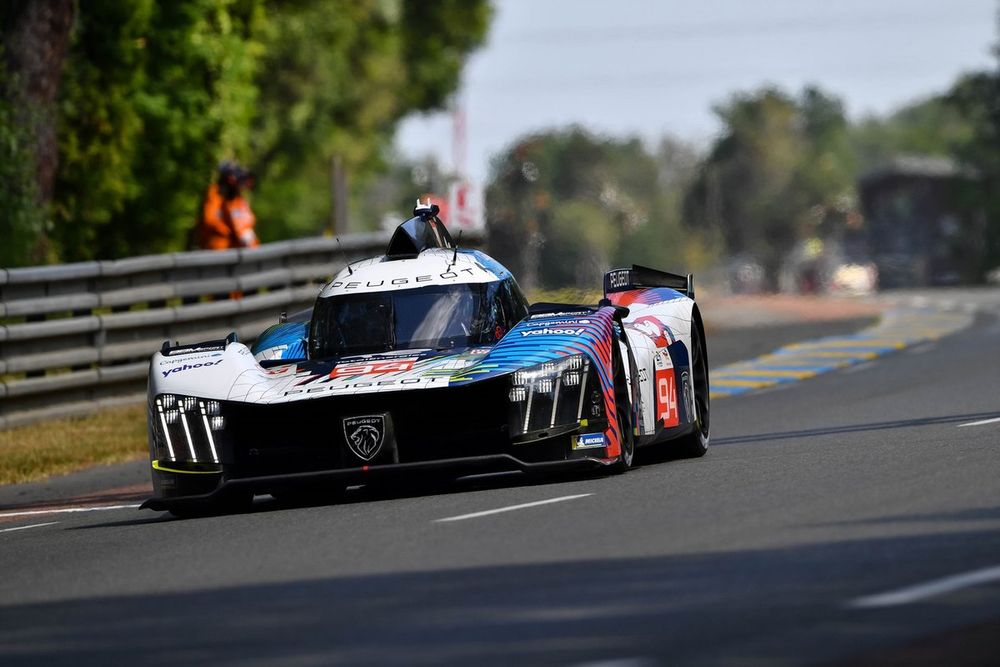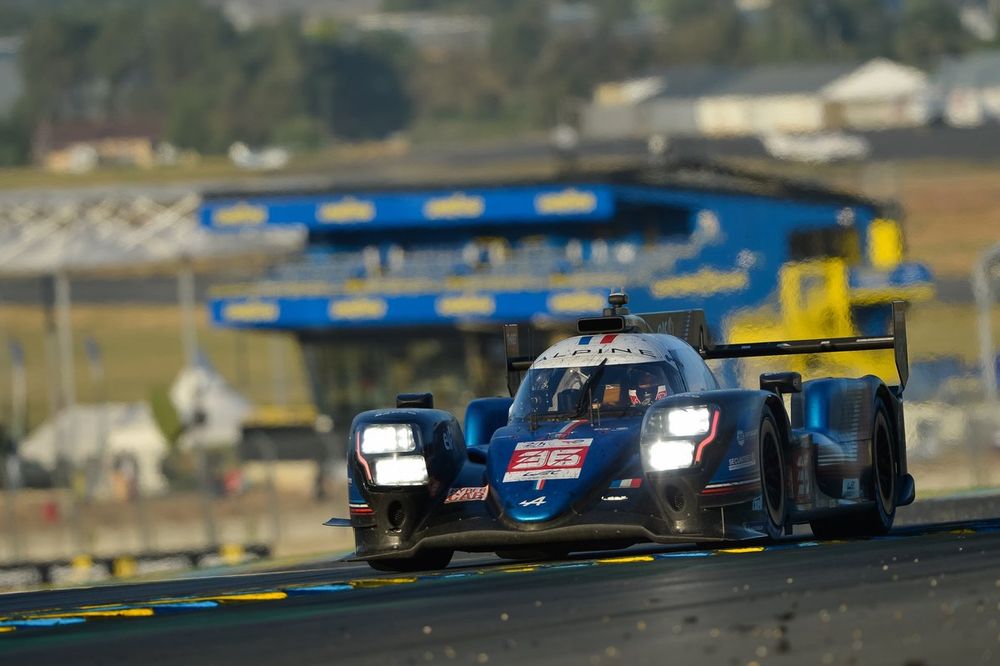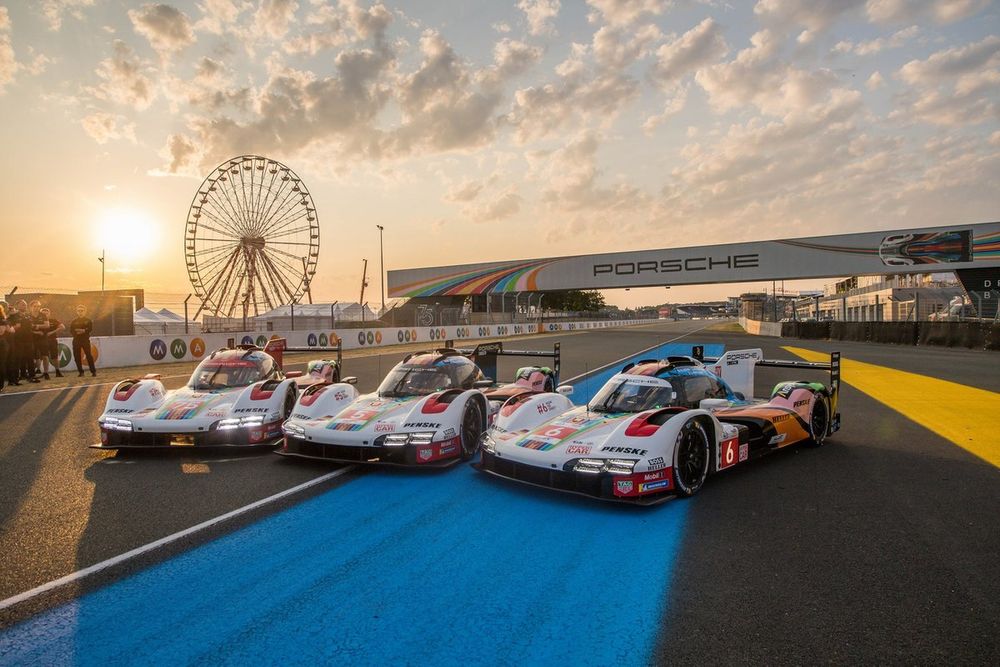That’s two different rulebooks to which a manufacturer can build a car for the top category of the series. So on the 16-stong Hypercar entry for Le Mans this year there are nine LMHs and six LMDhs.
What is LMH and LMDh?
LMH stands for Le Mans Hypercar, a rulebook that has been in force in the WEC since 2021. LMDh is new for 2023, but you’ll never see the name written out, it’s not officially an acronym.
But it is easy to guess what the letters mean given that the class was formulated by the Automobile Club de l’Ouest at Le Mans and IMSA based at Daytona in the USA. That little ‘h’ on the end refers to the fact that these cars, like their LMH rivals, incorporate hybrid technology.
The two types of car are very different in some respects, but actually very similar in others.
What’s the difference?
LMH allows a manufacturer to design and develop its own car from top to tail — or rather from the nose to the tail. That includes all elements of the hybrid system, which, if present, must be on the front axle. It is not mandated: the Toyota, Peugeot and Ferrari LMHs are all four-wheel-drive, but the Glickenhaus and Vanwall are non-hybrid machines that drive only through the rear wheels.
LMDh requires entrants to use a high percentage of off-the-shelf components. What is known as the spine of the car, including the monocoque and the suspension, must be one of the next-generation LMP2 designs from the four licensed constructors, ORECA, Dallara, Ligier and Multimatic.
The rear-axle hybrid system is common to all cars. It’s a combination of parts built by Bosch, Williams Advanced Engineering and Xtrac, who respectively supply the motor generator unit (MGU), the battery and the gearbox. The manufacturer only develops the aerodynamics, supplies the internal combustion element of the powertrain and has the freedom to do what it wants with the electronics.

Peugeot’s LMH 9X8 of Loic Duval, Gustavo Menezes, Nico Muller
Photo by: Marc Fleury
The concept of the cars may be very different, but the rules have been written to ensure that they achieve the same or similar level of performance. A key tenet of the LMH and LMDh are so-called performance windows into which each car must fit. The aerodynamic targets for downforce and drag are the same, as is the maximum power. The minimum weight for an LMH and LMDh is also the same.
A key principle of both LMH and LMDh rules is to allow the manufacturer to give the cars a distinctive look and to incorporate styling cues from their road cars. The most extreme is the avant-garde Peugeot 9X8 LMH that runs without a conventional rear wing.
What happened to LMP1?
Hypercar is the replacement for the LMP1 class, which can trace its origins back to the mid-1990s. It took over at the start of the 2021 WEC season when the first LMH cars came on stream.
The starting point on the road to the new rules was Porsche’s decision to end its involvement in the LMP1 class at the end of 2017. That left P1 high and dry: Audi had already departed the year before, leaving Toyota as the only manufacturer.
Rule makers the FIA and the ACO started to work on a successor in the spring of 2018. The key aim was a reduction of costs from the big-spending days of P1 when manufacturers were reputed to be spending well in excess of €100 million a season. That fed into the idea of allowing manufacturers to get their styling departments involved in the design of the cars.
By the end of 2018, the first iteration of the LMH rules had been published. No one could have imagined then the twists in the road that were to come.
The big two turns came in June 2019 and January 2020. At Le Mans in ’19, the idea of the Balance of Performance, a kind of equalisation process, was introduced and then six months later the LMDh concept was announced on the eve of the Daytona 24 Hours IMSA SportCar Championship season-opener.

Alpine was granted an extra year of homologation to run its LMP1 entry in 2022.
Photo by: Marc Fleury
It was an important moment in the history of motorsport because LMDh was conceived to allow manufacturers racing in the USA to also bring the same cars to the WEC. This so-called convergence process continued and LMH machinery is now allowed to take on the LMDhs in the North American IMSA series as well.
How fast are the new cars?
LMH and LMDh cars are significantly slower than their twin-hybrid LMP1 predecessors. The target lap time at Le Mans is 3m30s, which is approximately 10s slower than the P1s.
The fastest time around the 8.47-mile Circuit de la Sarthe by a P1 car was Toyota driver Kamui Kobayashi’s record-breaking pole position lap of 3m14.791s from 2017. That equates to an average speed of 156.512mph. The Japanese driver’s 2021 pole lap of 3m23.900s, a shade under 150mph, stands as the fastest lap at Le Mans in the Hypercar era.
Top speeds are similar, however. The Toyota GR010 HYBRID LMHs are peaking at around 340km/h or 211mph at Le Mans this week, which compares with a 342km/h maximum for its LMP1 predecessor, the TS050 HYBRID that last raced at Le Mans in 2020.
The big speed difference is in the corners and under braking. The LMH and LMDh rules set a minimum weight of more than 150kg higher in LMP1, which inevitably takes a toll on lap time.
Who’s competing in the new class?
Toyota was the only major manufacturer represented in Hypercar over the first season and a half of the class until the arrival of Peugeot after Le Mans last year. The Japanese manufacturer’s only opposition until then was provided by the Glickenhaus-Pipo 007 LMH and an Alpine-Gibson A480 LMP1 car. It was an ORECA design that previously raced as the Rebellion R-13 and was slowed significantly to bring it in line with the LMHs.
A flurry of manufacturers have signed up for the LMDh formula. Porsche was the first to begin the development of a car, which we know today as the 963, and was quickly joined by Cadillac, Acura and then BMW. Honda brand Acura and BMW are racing only in North America in 2023, but BMW will expand into the WEC next year.

#75 Porsche Penske Motorsport Porsche 963 of Felipe Nasr, Mathieu Jaminet, Nick Tandy, #5 Porsche Penske Motorsport Porsche 963 of Dane Cameron, Michael Christensen, Frederic Makowiecki, #6 Porsche Penske Motorsport Porsche 963 of Kevin Estre, Andre Lotterer, Laurens Vanthoor
Photo by: Marc Fleury
The other newcomers in 2024 will be Lamborghini and Alpine. The Italian marque will race in both WEC and IMSA from next year, while Renault’s sportscar brand will focus on the WEC in year one.
The interest LMH continued after the announcement of a cheaper route into the WEC via LMDh. Peugeot made its decision to return to sportscar racing for the first time since 2011 in November 2019 and evaluated LMDh before deciding to stick with its original decision to develop an LMH. Ferrari followed suit when it went public with its plans to end a 50-year absence from the prototype ranks as a factory in February 2021.
Le Mans 24 Hours Hypercar class entrants
| Entry Number | Teams and Drivers | Car |
| 2 | Cadillac Racing Earl Bamber platinum Alex Lynn platinum Richard Westbrook platinum |
Cadillac V-Series.R Cadillac LMC55R |
| 3 | Cadillac Racing Sébastien Bourdais platinum Renger van der Zande platinum Scott Dixon platinum |
Cadillac V-Series.R Cadillac LMC55R |
| 4 | Floyd Vanwall Racing Team Tom Dillmann gold Esteban Guerrieri platinum Tristan Vautier gold |
Vanwall Vandervell 680 Gibson GL458 |
| 5 | Porsche Penske Motorsport Dane Cameron platinum Michael Christensen platinum Frédéric Makowiecki platinum |
Porsche 963 Porsche 9RD |
| 6 | Porsche Penske Motorsport Kévin Estre platinum André Lotterer platinum Laurens Vanthoor platinum |
Porsche 963 Porsche 9RD |
| 7 | Toyota Gazoo Racing Mike Conway platinum Kamui Kobayashi platinum José María López platinum |
Toyota GR010 HYBRID Toyota T35V6TT |
| 8 | Toyota Gazoo Racing Sébastien Buemi platinum Brendon Hartley platinum Ryo Hirakawa platinum |
Toyota GR010 HYBRID Toyota T35V6TT |
| 38 | Hertz Team JOTA António Félix da Costa platinum Will Stevens platinum Yifei Ye gold |
Porsche 963 Porsche 9RD |
| 50 | Ferrari AF Corse Antonio Fuoco platinum Miguel Molina platinum Nicklas Nielsen platinum |
Ferrari 499P Ferrari |
| 51 | Ferrari AF Corse Alessandro Pier Guidi platinum James Calado platinum Antonio Giovinazzi platinum |
Ferrari 499P Ferrari |
| 75 | Porsche Penske Motorsport Felipe Nasr platinum Mathieu Jaminet platinum Nick Tandy platinum |
Porsche 963 Porsche 9RD |
| 93 | Peugeot TotalEnergies Paul Di Resta platinum Mikkel Jensen platinum Jean-Éric Vergne platinum |
Peugeot 9X8 Peugeot P26V6TT |
| 94 | Peugeot TotalEnergies Loïc Duval platinum Gustavo Menezes platinum Nico Müller platinum |
Peugeot 9X8 Peugeot P26V6TT |
| 311 | Action Express Racing Pipo Derani platinum Alexander Sims platinum Jack Aitken platinum |
Cadillac V-Series.R Cadillac LMC55R |
| 708 | Glickenhaus Racing Romain Dumas platinum Olivier Pla platinum Ryan Briscoe platinum |
Glickenhaus 007 LMH Pipo 35V8T |
| 709 | Glickenhaus Racing Franck Mailleux gold Nathanaël Berthon gold Esteban Gutiérrez platinum |
Glickenhaus 007 LMH Pipo 35V8T |
LMH performance stats
The base power output for both types of WEC racer is set at 520 kilowatts, which equates to 697bhp. Hybrid cars are not allowed to produce more than that figure from the internal combustion engine and MGU combined. These outputs are tweaked under the BoP to equalise the cars. The maximum power from the hybrid system is 200kW for the LMHs and 50kW for the LMDhs.
The advantage of running four-wheel-drive has been all but removed under the regulations. The speed at which an LMH can deploy hybrid power has been raised to a level, set under the BoP, where it offers little or no advantage in the corners. This speed is at the moment set at 190km/h for the Toyota and the Ferrari, while the figure is 150km/h for the Peugeot because it runs narrower rear tyres and therefore has less grip on the back axle.
The minimum weight is 1030kg for two-wheel-drive cars and 1040kg for four-wheel-drive cars. This changes under the BoP. The Toyota, for example, is running at 1080kg at Le Mans in 2023.
LMH and LMDh can be described as non-development formulae: the design of a design is largely frozen when it starts racing and there is only limited scope for technical developments made in the name of performance.
Only one aerodynamic specification is allowed; the days of manufacturers building low-drag versions of their cars for Le Mans are a thing of the past. They now have to trim their cars for different circuits with a single aero device.

#3 Cadillac Racing Cadillac V-Series.R of Sebastien Bourdais, Renger Van Der Zande, Scott Dixon
Photo by: Marc Fleury








